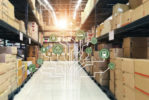
Home » Co-op Uses RFID to Track Plastic Bottles It Makes for Coca-Cola in U.S.
Co-op Uses RFID to Track Plastic Bottles It Makes for Coca-Cola in U.S.
July 29, 2009
Southeastern Container, Enka, N.C., was formed in 1982 under the ownership of a group of Coca-Cola Bottling companies. Today the company operates as a manufacturing cooperative, producing 70 percent of the plastic bottles used by Coca-Cola in the U.S. It also works with bottle manufacturers outside of the co-op. The company recently implemented an RFID asset tracking system.
Q: Give us a brief description of Southeastern Container's business.
Underwood: Southeast Container is a cooperative owned by a group of Coca-Cola bottlers. We manufacture for them unlabeled, unfilled bottles that they then fill and label. We have 10 manufacturing facilities across the East Coast and in Illinois and Wisconsin. At three of those facilities we have injection molding operations where we take PET [polyethylene terephthalate] resin in pellet form and produce what we call pre-forms. These are the thread part of the bottle attached to what looks like a large test tube. The pre-forms are shipped to our bottle-blowing locations where they are reheated and stretched and blown in a standard stretch-and-blow process.
Q: The assets you want to track are the containers for these pre-forms?
Underwood: That's right. Until now, we have been using mostly cardboard containers, which have a relatively short cycle life. They also have stackability issues that prevent us from maximizing the capacity of shipping trailers. And the cardboard containers often are pre-assembled to save time, which takes up a lot of warehouse floor space. These issues add up when you are shipping billions of pre-forms, so we decided to move to returnable plastic bins. We already had a few plastic bins in use, but they were not optimized for loading on a trailer or for efficient return of empties.
The 30,000-plus new plastic bins we are adding to our system are collapsible. They fold down on four sides into a nice, compact shape so that we can maximize their return to our injection operations. But these containers cost a lot more than cardboard and we wanted to be able to count their delivery/return cycles so we could track that against the number of cycles guaranteed by the manufacturer.
Q: Why did you decide to use RFID for this?
Underwood: Well, we already use and will continue to use barcodes to identify the contents of each box or bin, but that content changes with each cycle and a new barcode has to be applied. So the barcode can't tell us how many cycles a box or bin has been through. As I mentioned, the bin manufacturer guaranteed a certain cycle life on these bins, and the only way to ensure that we get that guarantee is to count the cycles as the bins go through our system.
We looked at using a separate barcode to identify the bins but barcodes can come off and they are quite fragile - you get a scratch on them and they may not read well. An RFID tag, on the other hand, is rather permanent and rather protected, which ensures, with a high degree of certainty, that we can get an accurate cycle count on the bins.
As a piggyback on that, we are doing some other things with the tag information. For example, when we barcode the unit, we also read the RFID tag and associate both of those pieces of information, so we know what that particular bin contains. This provides a backup in case the barcode is not read for whatever reason - maybe it falls off or is damaged. As the bin makes its way back through the return cycle and we read the RFID tag, if we don't have a record of the contents having been dumped, because the barcode scan failed at that point, then we go ahead and remove it from inventory based on the RFID read.
As we go forward in time, we will probably use RFID more than barcodes, but we are not ready to get away from barcodes entirely because the barcode label also contains some human readable text.
Q: I believe you worked with a consultant to come up with the best RFID solution for your operations?
Underwood: Yes, we worked with DecisionPoint Systems, a company that we had worked with in the past. They have done a lot of work with RFID so we had them do an RFID tag survey for us. There are a host of RFID tags out there and different ones work better under certain conditions and around certain materials. Rather than us trying to go through the gamut and figure all that out, we decided to use their expertise in this area and let them do that for us. So they took a few samples of our bins and our products and put them through a litany of tests with various RFID tags to identify the tag that would give us the most reliable and largest range of readability. They presented us with a report that had a matrix of information showing why they recommended the tag they did based on our products and read environments. They did a very good job and the tag they recommended, which is an Alien tag, has worked very well for us.
Q: It is a permanent tag?
Underwood: Yes it is a permanent asset tag that we encode with a unique serial number and with some other information that helps us determine what type of bin it is. Basically, it is a pretty generic Gen 2 tag.
Q: Tell us about your system of readers.
Underwood: We are using Motorola XR440 fixed readers with Motorola AN400 antennas. For our initial implementation, we are installing a single read point at each of our three injection molding operations. This basically is a read portal that every bin passes through at the point where we apply our existing barcode label that identifies the bin's contents. So at the outset here, we really only have three portals in our whole organization, each positioned at the location where we apply barcode labels to filled bins of product. When we apply that barcode label we also read the RFID tag and associate that information.
Q: Was this initial implementation a pilot program?
Underwood: DecisionPoint installed and tested the first fixed reader for a pilot using some of our existing plastic bins, which we tagged. We collected the data and validated that we could read the tags reliably and that we were not reading other tags that were passing by. We made a few adjustments to our antenna and such to prevent that from happening, but basically it was plug and play. They set it up and it worked. Even with all kinds of metal conveyors around, the reader and the Motorola AN400 antenna are outstanding on the plastic bins. We can read the bins in any orientation, up to 20 feet away if we choose.
Long-term, we are looking at placing many other portals along the cycle life of a bin to help us determine where that bin is at any given point. Right now, the only thing we know is about a particular bin is that it got a barcode applied and it is somewhere in the system - we don't know whether it is in a warehouse or in transit, whether it has been received at an blow-molding facility, or whether it is on its way back or has been received back. By putting additional read portals out there, we can have access to information about where those products are at any given time, which will give us a better handle on our inventory. We can know things like how many bins we have in the warehouse, how many bins we have in transit, how many bins we have received at one of our blow-molding facilities, how many empty bins have they sent back and how many we have received back in our warehouse that are available to be filled with goods. These are things we don't know now, but we are looking hard at acquiring these capabilities as time and money allow.
Q: I take it you are also using hand-held scanners at receipt?
Underwood: Currently we have a lot of the Motorola MC9090 handhelds across the system and we recently placed a fairly large order for more of those. These handhelds are able to capture data from both barcodes and RFID tags and we are confident they will hold up in our demanding environment. Also, using Motorola's Mobile Services Platform, we are able to update these devices with custom programs so we can use them for different operations, such as tracking spare parts.
Q: Is there other software you are using with this system?
Underwood: Yes, we use OATSystems' Oat Asset Track software on the fixed readers. We may also use this software on the MC9090 handhelds in the future as we consider other opportunities for asset tracking across the Southeastern Container enterprise. Looking ahead, we are considering a similar RFID system for real-time tracking of outbound shipments and return dunnage.
Q: What is the guaranteed life of these containers?
Underwood: It is measured in cycles and we don't yet have enough information to estimate how many cycles we will get in a year, but I expect about a 10-year life. It is quite long and we don't want to shortchange ourselves on that, which is why we want to do the cycle counting.
We expect this project to have a very good return on investment. I don't want to give out specific numbers, but the payback will come from maximizing the shipment of pre-forms, which will save on transportation costs. We also will be able to maximize storage within our warehouse. We can store these bins in a smaller space because we can stack them higher, so we gain some savings there. We also gain savings on the return of dunnage. We can get many, many more bins in a trailer for the return trip than we could with cardboard.
RELATED CONTENT
RELATED VIDEOS
Related Directories
Subscribe to our Daily Newsletter!
Timely, incisive articles delivered directly to your inbox.
Popular Stories
-

-

Charting a Sustainable Path: Retail Supply Chain Evolution in 2024
-

Diversifying Production From China: Welcome to ‘The Great Reallocation’
-

U.S. Fleet Professionals Look Toward Sustainability to Cut Down on Rising Operating Costs
-

Next-Generation Packaging Brings Reliability and Visibility to Supply Chains

2024 Supply Chain Management Resource Guide: There's Only One Way Off a Burning Platform
VIEW THE LATEST ISSUECase Studies
-
Recycled Tagging Fasteners: Small Changes Make a Big Impact
-

Enhancing High-Value Electronics Shipment Security with Tive's Real-Time Tracking
-

Moving Robots Site-to-Site
-
JLL Finds Perfect Warehouse Location, Leading to $15M Grant for Startup
-
Robots Speed Fulfillment to Help Apparel Company Scale for Growth